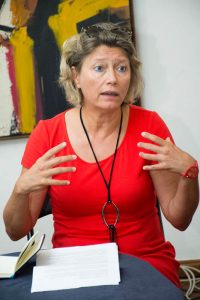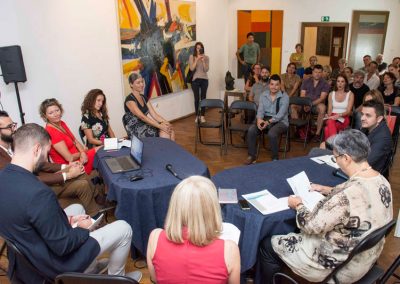IN DIALOGUE WITH ANOUK LEDERLE
At the Round Table with the theme “Timisoara – Novi Sad, the current art scene and perspectives of cooperation on the way to the European Capital of Culture 2021”, cultural workers from Novi Sad took part: Tijana Palkovljević Bugarski, head of the Matica Srpska Gallery, Sanja Kojić Mladenov, curator of the Museum of Contemporary Art Vojvodina, Vesna Latinović, director of the Danube Dialogues Festival, Maja Erdeljanin, artist and editor of the Mali likovni salon KCNS, Vuk Radulović, Head of Development Projects at the Novi Sad Foundation 2021 and guests from Timisoara: Sorina Jecza, co-founder of the Art Encounters Biennale Foundation “Triade”, Bogdan Kotrca, production manager of the Foundation “Timisoara 2021”, Andrej Jecza, editor of “Jecza” gallery from Timisoara and Anouk Lederle, cultural and communication manager at the French Ministry of Culture. Given that Anouk Lederle set the stage for the presentation of the main educational and research institutions in cultural policy and management, and that she was the initiator of cooperation between the art festivals of these two cities, after the round table was finished, we asked her to summarize her impressions about the advantages and opportunities which twin towns, Timisoara and Novi Sad have at this moment, toward the year 2021.
DD: You were participant at the Round table we had during DD2018 in Novi Sad. Since you have heard the other participants and other points of view, how would you describe your opinion about further possibilities of cooperation?
AL: Three years after my long stay in Timisoara and Belgrade, participating in the Danube Dialogue 2018 edition is a unique occasion to draw a new picture of the situation of contemporary art in the region.
Let’s draw a picture of the situation before the proclamation of ECOC in both cities Timisoara and Novi Sad? Mostly they look like twin cities: same number of inhabitants, same architectural spirit, same Heritage of Austro Hungarian Empire. And they are also special cities, independant cities with unusual personality: Novi Sad belonging to Vojvodina or Serbia, Timisoara as a prosperous capital of the Banat with loose links to Bucharest. Only 150 km between them, so close, regarding Western European scale, they are neighbours.
Regarding the contemporary art scene both cities are provided with strong galleries, “Bel Art” in Novi Sad and “Jezca” in Timisoara, and a very active underground network. The two of them have already drawn an artistic signature in the region with their respective festivals: Danube Dialogue Festival for Novi Sad and Art Encounters Biennial for Timisoara. It’s also a very good point that those festivals have different approaches: Danube Dialogue Festival building on the same team (Vesna Latinovic, Founding Director and Sava Stepanov, Art Director) and dealing year after year with cutting-edge issues related to 21st century challenges; on the other side, a Founding Director Ovidu Sandor for Art Encounters, presenting for each Biennial a new team of associated curators (man and woman) and a new topic. Both reach far beyond national boundaries of the art scene. They have to take advantage of each other and to be linked in order to be spoted on European and contemporary art Map. Together they will be stronger. In the perspective on European Capital of Culture in 2021, they must take a step towards each other. They have to draw near to this aim.
DD: Since you were the link that started this cultural exchange between Novi Sad and Timisoara, two future European capitals of culture, in countries connected by Danube, what in your opinion IS and what SHOULD BE the focus for our two cities in creating successful cultural dialogue between two cities and our two European countries?
AL: They have to be pushed further and supported by ECOC teams. A common project between those two main artistic events in East Europe has to obtain facilities like: shuttle between the two cities, buses, train facilities in order to facilitate meetings between professionals (artists, curators, cultural mediators, technical staff), volunteers and public. Twinning projects (curators, artists, volunteers) have to be set up. Artistic residencies has to be settled. Translation is also a crucial issue, communication tools should be created in 3 languages (Romanian, Serbian and English).
https://www.goodreads.com/book/show/36386684-ghid-de-art
A good starting point should be the ‘Artistil Guide: Introduction to Romanian Contemporary Art’ by Sorina Jecza & Maria Orosan-Telea which can be implemented by an exhaustive research of mapping contemporary art scene in Timisoara and in Novi Sad and in both surrounding areas. It can offer an interesting showcase for the artists and for the underground scene, be a crucial tool for professionals of art (art dealers, curators, collectors) and for the larger audience give some advice to better understand the contemporary art scene. The research can be provided by students from Serbia and from Romania and should have been translated in three or four languages. Perhaps the French Cultural Institute would give a hand in that tasks.
Some call for tenders could be done to create long lasting links between artistic project holders from the civil society and private sector. The aim is to build a stronger connection based on artistic field.
It’s not enough to build a project it’s also crucial to talk about it. Mapping Timisoara and Novi Sad in the contemporary art scene means it has to be spread from outside! As I’m leaving in Paris, I will be delighted to be a mediator with the Serbian Cultural Institute and the Romanian Cultural Institute to set up an action plan to contribute to the promotion of ECOC21.
Contemporary art is definitely a key point to give a new fresh and dynamic spirit for both ECOC. Art can change the vision of the populations and the vision of the tourists. Art can break the codes by promoting the idea of excellency of contemporary art and offer a real platform of discussion to reflect the major problems and issues in both countries. Art can be seen as a mediator for political issues.





